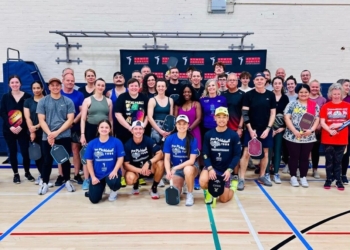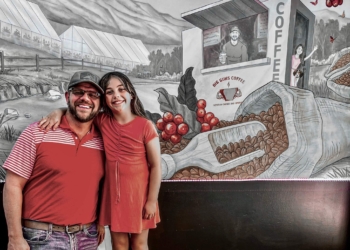Juan Reyes’s military pride can be sensed just by looking at his surroundings: book shelves filled with recounts of pivotal historical events, like the Battle at Gettysburg, and paintings of red poppies, the veteran remembrance flower. Looking straight ahead with deep dark eyes that reveal his suffering, as well as an inspiring and positive outlook on life, Juan sits in his motorized wheelchair next to his sister, Angie Ramirez, who has been his in-home caregiver for the past three years.
In 2016, Juan was diagnosed with Amyotrophic Lateral Sclerosis, commonly referred to as ALS — or Lou Gehrig’s disease. It is a progressive neurodegenerative disease that affects nerve cells in the brain and the spinal cord, according to the ALS Association, and veterans are twice more likely to suffer from ALS than civilians. In the United States, there are roughly 4,220 veterans who have been diagnosed with ALS.
Although medical research still needs to figure out the link between military service and the diagnosis, one theory could be based on the fact that “those in the military have a higher risk of being exposed to environmental pollutants such as lead, pesticides, and other toxins. Another is that the extreme physical exertion that servicemen and women undergo may also heighten the risk.”

The diagnosis
In 1986, Juan enlisted in the Air Force as a medic and served for 21 years. Throughout his military career, he and his wife Meg have gone on many adventures together that took them to Greece, the United Kingdom, and Washington, DC, among many other locations both in country and abroad.
After retirement, Juan became a police officer for the San Jose Police Department. It was three years ago when his life took an unexpected turn.
“When I found out his diagnosis, I was devastated,” Angie admits. “It was very hard to see my mom receive the news and how she took it. It was just something that came out of nowhere and it was life changing for the whole family. It hasn’t been easy, and every day is a challenge.”
Beginning with muscle weakness and slurred speech, Juan was told by his doctor that he surely did not have ALS. Unfortunately, this is not uncommon, as 40 percent of patients are misdiagnosed, mostly because the disease is a hard one to recognize as its early symptoms mimic other neurological diseases.
Within a few months, however, Juan was in a wheelchair, unable to stand or walk for extended amounts of time. The prognosis is two to five years. Juan is currently in his third year of this journey.
His daughter, Jessica Sparks, was able to capture on video the last standing dance he had with his wife of 37 years. At the time the video was shot, nobody in the family knew Juan had ALS.
Living with Lou Gehrig’s disease
In a slow yet clear and eloquent way, Juan describes that “ALS robs you of your ability to move, to use your hands, your legs and, as the condition progresses, it can take away your ability to speak, swallow, which of course affects eating. Ultimately, I would say the worst effect that it has is affecting your ability to breathe independently. Many patients end up on ventilators with a tracheotomy due to the fact that they can no longer breathe independently. It’s a condition that affects the entire family; it can be financially devastating, but I would say that the greatest toll is emotional and psychological.”
Taking a brief pause to clear his voice and catch his breath, Juan adds, “It really does take everything from you and makes you dependent on others for everyday activities, which is why it’s important to have a dedicated caregiver, such as my sister Angie.”
The daily role of a caregiver
During the interview, Angie sits in an armchair next to him, her upper body leaning toward her brother, a clear sign of her commitment and love for him. She describes what their daily routine is.
“Every day, I get my kids going to school since I do have two little ones at school still. Then, I get to my brother’s house and we get our routine going: Getting him ready for the day, getting him dressed, showered, changed, then breakfast and medications, and then just see what’s on our schedule for the day. It can be appointments, shopping—which my brother likes to do—and then just some of his advocacy work that he likes to put his time into,” Angie explained.
While Juan is lucky to have Angie as his in-home caregiver, they do face multiple struggles together, as his “weakness is progressing, and it takes a bit more time to get places and to do things.”
The noticeable progression of the disease “it’s hard to see every day,” Angie says. She wishes there were more “resources, so we can learn more about [the patient’s] needs and what is ahead. Right now, it is still okay. He can still eat and maybe walk a little, but as the disease progresses, there will be a need for more assistance, more training.”
An ‘unrelenting and unforgiving’ disease
Clearing his voice again, and catching his breath, Juan explains, “ALS is unrelenting and unforgiving. It demands so much from the patients, and their support system, specifically caregivers. I would encourage those individuals that are providing day-to-day assistance to ALS patients to first and foremost take care of themselves. It’s very strenuous, it’s very demanding, and the patient cannot care for themselves, especially as the condition progresses. The caregiver needs to take care of themselves emotionally and physically. Ultimately, the caregiver will feel the effects of the emotional toll [of] caring for someone that needs so much care and assistance.”
According to Juan, while the VA is “trying very hard to meet the needs of those affected by ALS, every year, when the federal budget conversation begins, it is a challenge. It is up to us as veterans and citizens to encourage elected officials to continue supporting both the caregivers and the patients, to support research and access to new treatments and therapies. It’s invaluable for us to raise our voices and help our elected officials understand that the need is very pressing, especially for us affected by ALS.”
Tilting his head towards Angie, as if trying to get even closer to his sister, Juan says that what helps him and his family face this unimaginable reality is “having a good sense of humor and just a positive outlook, realizing that there is still plenty of life to live, and many more memories to be made with our loved ones.”
Go to #ALSWarrior to follow and support Juan Reyes on his journey with Lou Gehrig’s disease.
If you are a veteran or caregiver seeking resources, the ALS Association has dedicated a section of its website to this topic.
Read comments







































